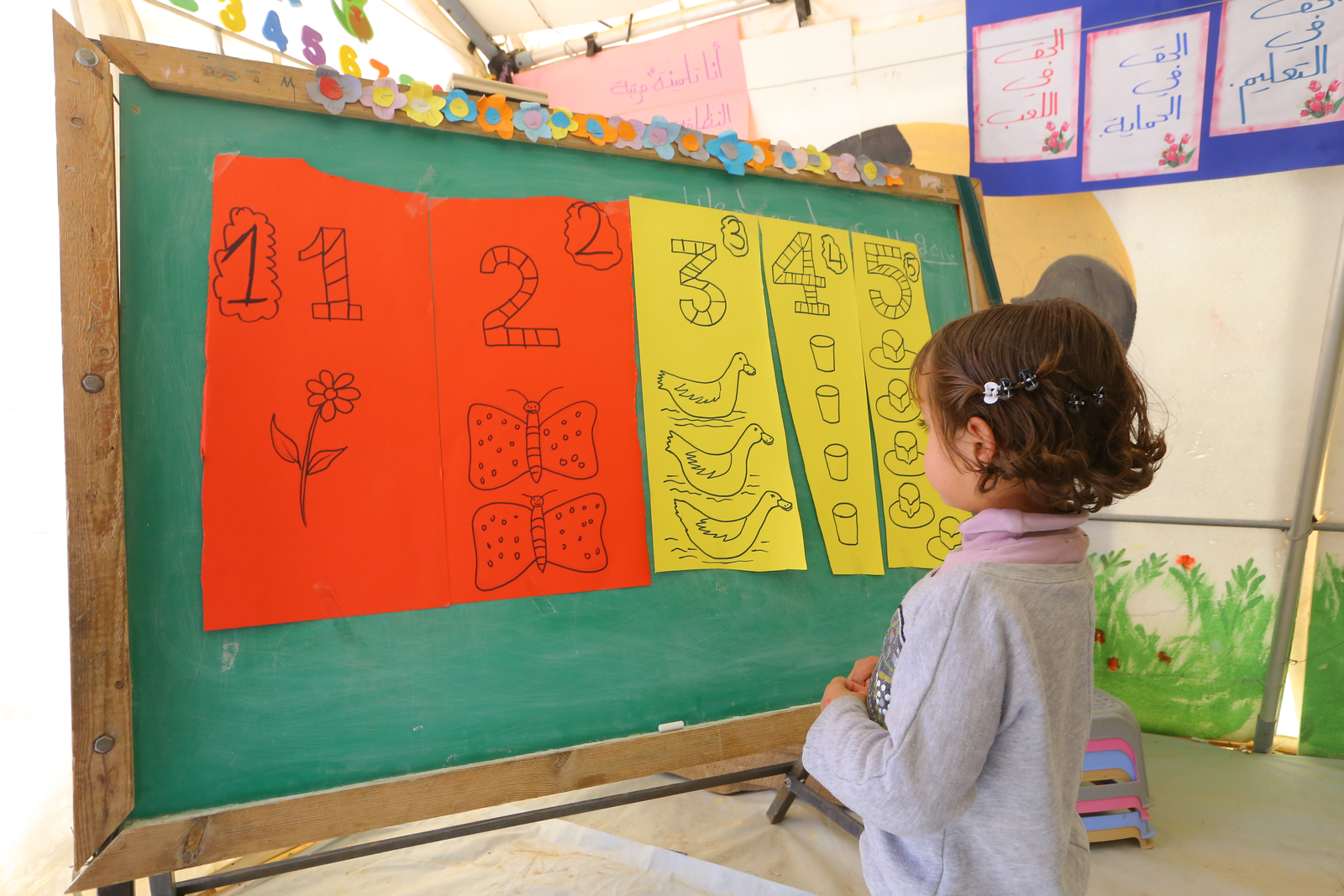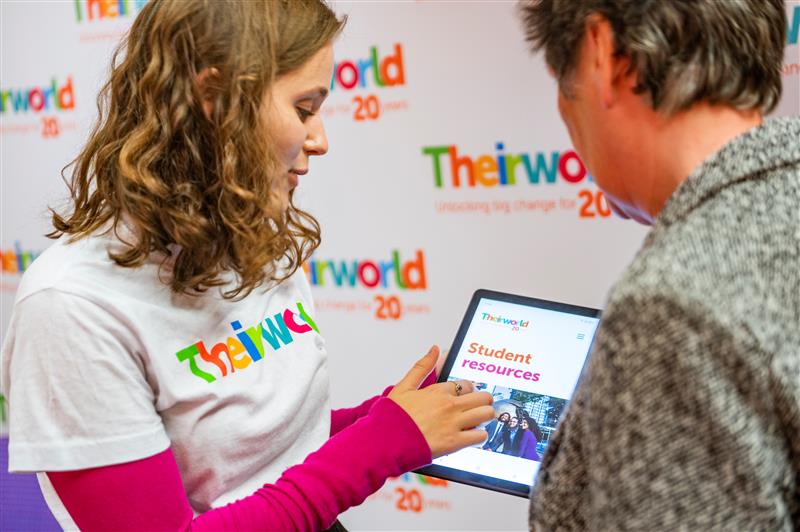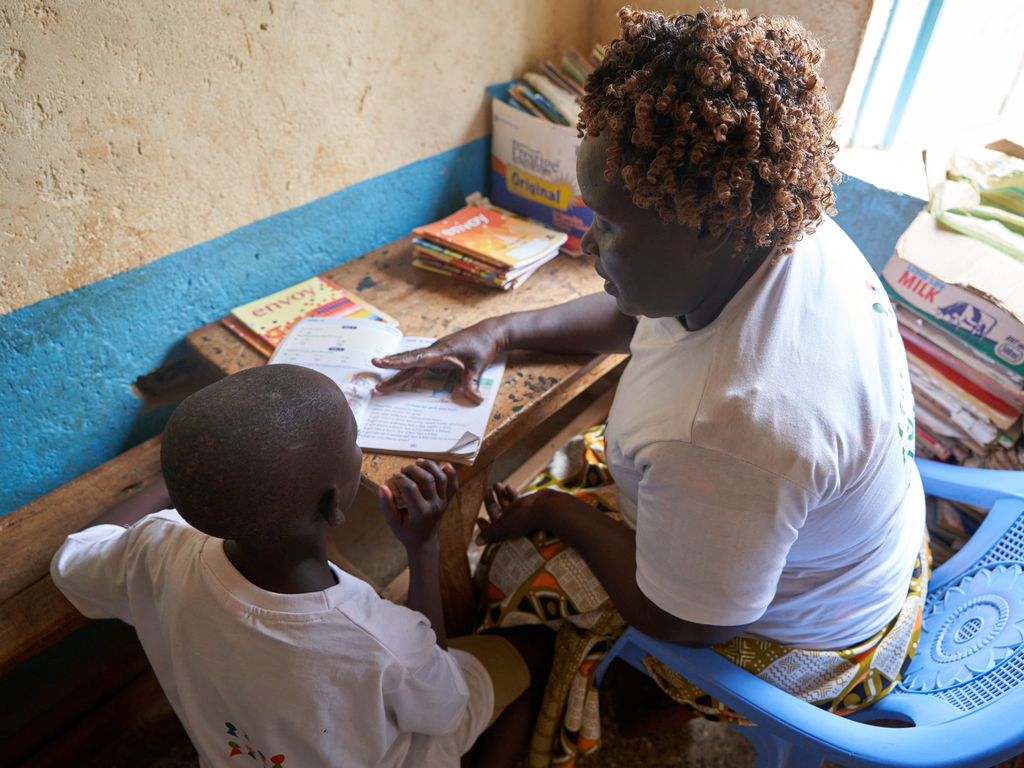
They fled from Islamic State – now these Yazidi children are learning again
Children in conflicts, Education in emergencies, Refugees and internally displaced people, Right to education, Teachers and learning
In a camp in Kurdish-controlled Iraq, we meet families whose children are being supported by a local university and a school to return to some kind of normality.
Dancing in a thunderstorm as lightning flashes across a dark sky, Yazidi children hold the palms of their hands upwards to catch rain drops.
As we enter their camp, they splash in puddles and yell with excitement and some shout out the odd word of English.
“Hello! Hello!” hollers a young boy wearing a Barcelona football shirt, as we run for cover to the home of one of the 13 families in this makeshift camp.
There are 100 people living here in basic huts, in the shadow of the plush seven-star Divan Hotel that towers above this tiny encampment.
We are in Erbil, the capital of Kurdish-controlled land in Northern Iraq – known as Southern Kurdistan to the Kurds.
These are Yazidi refugees who have been living in the city as internally displaced persons (IDPs) since escaping Islamic State (ISIL) in 2014, a small community whose children are now being supported by a local university and school.
These families are from Shingal, also known as Sinjar – a town which came to the world’s attention nearly three years ago when ISIL invaded suddenly and committed mass murder.
Slideshow: the Sinjar Yazidis – pictures by Angela Catlin
During wanton violence, the Islamists massacred at least 5000 people. They also abducted hundreds of young Yazidi women who were forced into sexual slavery.
Thousands more Yazidis fled for their lives – including the people who came here to Erbil. With an uncertain future, they live in a part of the Kurdish capital called Dream World – although conditions in this camp are in stark contrast to the surrounding wealth.
We are welcomed from the downpour into a family’s home. We leave our shoes at the entrance and sit on rugs on the floor.
“This is beautiful, what a privilege this is,” says Tracy Fenton who is a 49-year-old artist from Bolton. She is hosting our visit to the Yazidi camp with a colleague called Deborah Morgan-Jones.
These women are both from England and they work at the University of Kurdistan, which has been supporting the Yazidi families since last autumn.
We are offered tea and biscuits and a young Yazidi girl called Samira, aged 12, does her best to translate my questions, although much seems to get lost in translation. I ask what her grandmother likes about living in Erbil.

“In Sinjar, everything is broken after Daesh came. It is not good, it is very bad,” is the reply. “Kurdistan, Hewler (Erbil) and the Peshmerga have been very good to us.”
Fenton – who studies creative education at Salford University – came to Iraqi Kurdistan in January. She says that while the Yazidis are content living in Erbil, they all wish to return to Sinjar although political instability means this is currently not possible.
She adds: “A few weeks ago I was doing a project with them and said, ‘Draw something that makes you happy’…and every single one of them drew the houses they left behind.”
The majority of Yazidis consider themselves ethnically Kurdish and they are religiously distinct from Iraq’s predominantly Sunni Kurdish population.
Yazidism is an ancient faith that integrates some Islamic beliefs with elements of Zoroastrianism, the ancient Persian religion, and Mithraism, a religion originating in the Eastern Mediterranean.
Estimates put the global number of Yazidis at about 700,000, with the vast majority concentrated in northern Iraq, in and around Sinjar. For their beliefs, the Yazidis have been persecuted for centuries and they are considered heretical devil worshippers by ISIL, who wanted to wipe them out in 2014.
It is difficult to imagine what these Yazidi families have suffered. As we speak, one young girl draws her hand across her throat when she utters the word “Daesh.”
Fenton says that to be invited into a Yazidi home is extraordinary because they can be extremely insular – particularly these families who choose to be separate from other Yazidi IDPs who are housed in larger, official camps elsewhere in Kurdish territory.
“These are very inter-connected families and they are Sinjar Yazidis who are very fundamental…if we were to try and make a parallel with UK society then these would be travellers, perhaps Romany Gypsies. They want to be together – but on their own and away from other IDPs,” Fenton explains.
We’d met her earlier at the University of Kurdistan in Erbil, along with Professor Jamal Rasul, who is a former refugee and minister of planning with the Kurdistan Regional Government. He is now principal at the educational institution.
Professor Rasul said there are currently more than two million refugees and IDPs currently living in Iraqi Kurdistan. They include hundreds of thousands of Syrians and also Iraqis who fled the Battle of Mosul.
A refugee himself once in Iran, Professor Rasul said: “Today, Kurdistan is a safe area. People from all over Iraq have come here. I know how hard it is to be a refugee. The rest of the world has a moral responsibility to keep Kurdistan on its feet. We are looking after more than two million people.”
One group of university students teach the Yazidi children to speak English while another team wants to entertain them with puppets and theatre
Due to the recent mass influx of people into the region, the University of Kurdistan now has lecturers and students who are IDPs and refugees.
For the Kurds, it means that the demography of their territory is changing rapidly, with 30% of populations now Arab in major Kurdish cities such as Erbil, Duhok and Sulaymaniyah.
“Acceptance is now having to be practised (by Kurds),” Professor Rasul added.
It was last September when the university was asked to help the small Yazidi community. Deborah Morgan-Jones – who has researched post-traumatic stress disorder within refugee communities – was approached by a think tank called the Meri (Middle Eastern Research) Forum.
“No was not an option so I took it to the vice-chancellor and he thought it was fantastic – so we set up a recruitment programme for students,” she said.
The university’s subsequent call for help led to 47 students volunteering and they now visit the camp, in groups, three times a week to assist with teaching.
We meet with some of the university students after speaking to Professor Rasul. They are in a classroom sharing ideas on how to help the Yazidi children. There are five teams who usually visit the camp for two hours at a time.
One group says it has completed two sessions already to teach the Yazidi children to speak English while another team wants to entertain them with puppets and theatre.
“If something works, we tell the others about it. Likewise, if something doesn’t work – or if any of the kids are playing up,” says Fenton.
She came on board in January after writing to the university. She’s a therapeutic artist who worked with refugees in Bolton and her work with the Yazidis is part of her research for a masters degree.
She said: “In December, I just had a real pull on my heart that I need to come here, so I emailed the vice-chancellor and told him who I was and what I wanted to do. I asked if he could find a place for me to work with his students and within three days I literally had a job. So I flew over just after Christmas.”
Artist-in-residence at the university, Fenton works with both staff and students, helping people to deal with any trauma they’re suffering. Many students – impacted by war – are extremely fragile.
She’s also working therapeutically with the Yazidis, some of whom witnessed carnage in Shingal. At Salford University, she examined the loss of occupational identity faced by refugees and a main focus of her work in Erbil is helping Yazidi women who have lost nearly everything.
“Becoming an IDP isn’t just about losing your home, it’s about losing your actual identity … you lose your role as a mum, as counsellor, as a taxi driver – you lose everything that you maintained and created in your community,” Fenton says.
She adopts a therapeutic approach as opposed to therapy.
“It’s a softer approach, it’s hands-on, loving people back to life,” she says. “These people are flat-lining. I call it loving people back to life through creativity.”
As part of the project, she’s been helping the women to make clothes to sell – a livelihood project to help them become social entrepreneurs and get an income. It’s about tapping into their skills and giving them confidence. The men can pick up casual work.
“It’s not like back in England when they can stay home and live off benefits. Here, if they don’t work they don’t get anything,” Fenton says.
Another aim at the outset was to get young children into primary school and the university has been helped by a local school called Sabat, which offered to take 40.
For now, these people have some stability but the future of this community – and tens of thousands more Yazidi IDPs – remains unclear.
Sinjar – largely destroyed by ISIL – remains politically unstable as various factions vie for control and it is unknown what might happen when ISIS is eventually cleared from the Iraqi city of Mosul, where the terror group is battling Iraqi forces.
But what is certain, is that the University of Kurdistan will continue to help the Yazidis for as long as they stay in Erbil.
“This is a vocation, not a profession. It’s got to come from the heart,” Fenton says. “You get a lot of people who want to do this, with the right intentions, but they often fall away.
“The kids…you just love them. You cannot not love them. The way that everyone’s come together has been amazing. It’s just wonderful to see it growing so beautifully.”
More news

Take the test and discover how our Schools Hub helps students grasp the global education crisis
